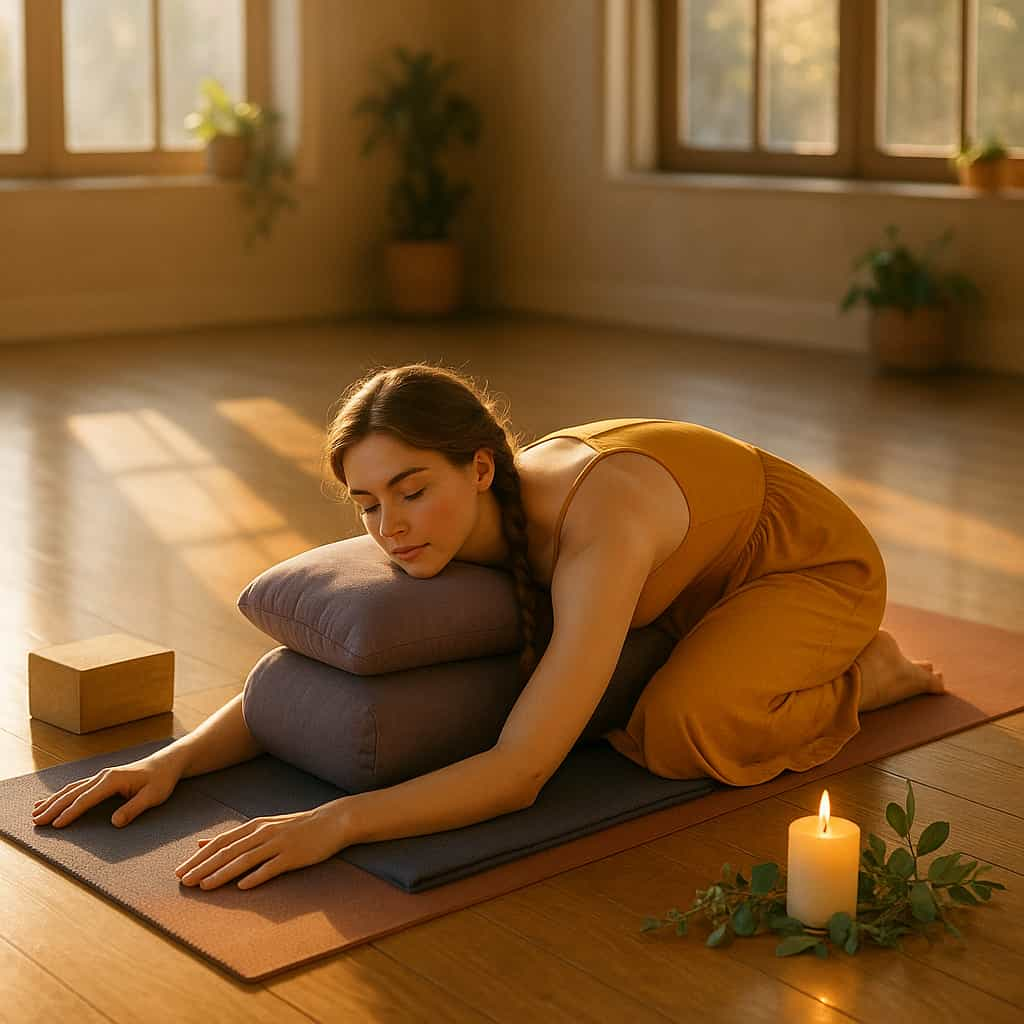
Intro: What Is Restorative Yoga?
First things first, imagine this: You’re curled up on a pile of cushions like a contented housecat. Meanwhile, your only responsibility? Absolutely nothing. That’s the magic of Restorative Yoga – the laziest (and most brilliant) stress-buster around.
Now, in our nonstop world of “hustle harder!” (we’re looking at you, 3pm caffeine fixes), this practice gently counters: “Hey, what if you just… stayed still?” Here’s the deal: You’ll sink into props – bolsters, blankets, maybe even that lonely sock puppet – and hold poses for full minutes. Not seconds. Minutes. (Relax, you’re going to love this.)
So how does this sorcery work? Essentially, it switches your nervous system from “EMERGENCY MODE” to “ahhh, human burrito time.” Researchers call this “rest-and-digest.” I prefer “finally, a workout that doesn’t require workout clothes.”
Specifically great for:
- Anxiety (the “why did I just diagnose myself via Google?” variety)
- Burnout (when your brain feels like day-old spaghetti)
- Modern humans who’ve forgotten what “off switch” means
And listen up, flexibility-challenged friends: this isn’t about twisting like a pretzel. Rather, it’s about becoming one with your blanket. Honestly, your stress will be sending you thank-you notes.
In conclusion? In our hyper world, this is your official permission to stop. So grab that pillow, find some floor, and let your inner sloth rejoice.
Why Choose Restorative Yoga?
Let’s be real—life is loud. Between work, responsibilities, and that one relative who always texts at 6 AM, stress piles up like dirty laundry. But here’s the thing: Restorative Yoga? It’s your chill pill in practice form. So, if you’re wondering whether to try it, here’s why you absolutely should:
1. Turns You Into a Puddle of Relaxation
First off, forget “working” in a pose—this is supported laziness. Thanks to bolsters, blankets, and blocks holding you up, your muscles can finally quit clinging for dear life. Best part? Deep breaths happen automatically (because, let’s face it, you’re too comfy not to sigh).
2. Kicks Stress Hormones to the Curb
Here’s the science: Restorative Yoga lowers cortisol (a.k.a. the “why am I like this?” chemical). As a result, you get better sleep, fewer meltdowns over spilled coffee, and—finally—actual emotional balance.
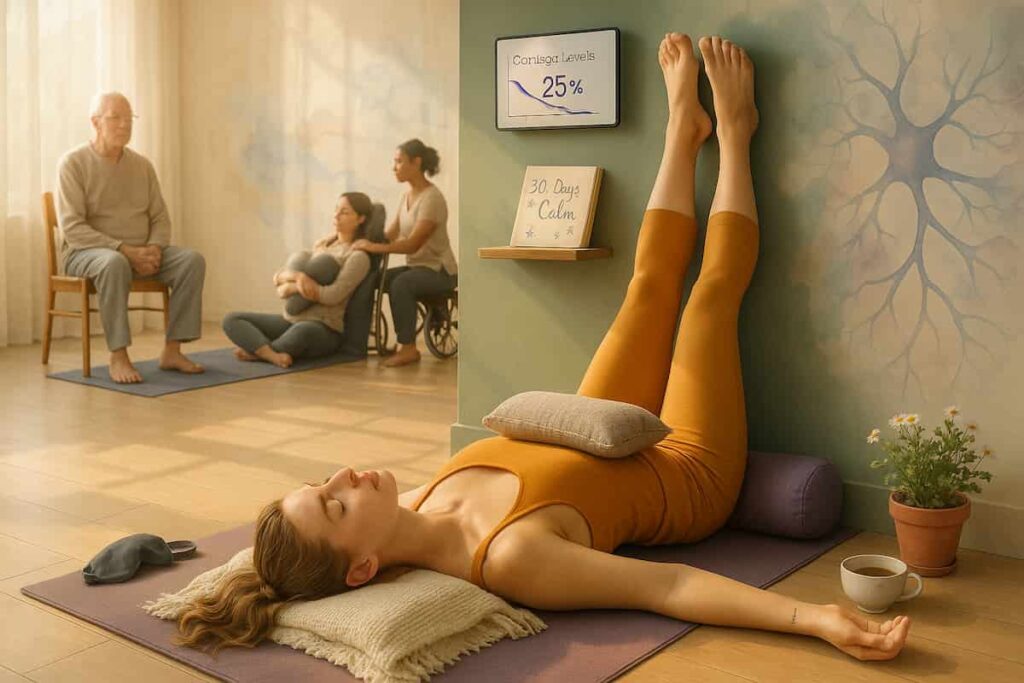
3. Healing Without the “Work” Part
This one’s perfect if you’re dealing with:
- Injury (no pushing limits—just gentle support)
- Burnout (when your brain feels like a fried egg)
- Chronic fatigue (because “just power through” is terrible advice)
Bottom line? Your nervous system gets to fix itself—no sweat required.
4. Zero Flexibility Needed
Seriously, can you lie down? Then congrats, you’re qualified. Whether you’re stiff, sore, or “I haven’t moved since 2019,” Restorative Yoga is for you. Here’s how it works: Props do the heavy lifting; you just exist gloriously.
5. Sleep Like a Baby (Who Actually Sleeps)
Struggling with insomnia or midnight overthinking? After just a few sessions, your brain rewires from “must solve all life problems at 2 AM” to “zzzz…” Plus? You’ll wake up less grumpy—win-win.
Beginner-Friendly Restorative Yoga Poses
Look, nobody expects you to bend like a gymnast or meditate like a monk. These restorative yoga poses are easier than deciding what to watch for dinner (we all know it’s gonna be toast anyway).
1. The “I Give Up” Pose (Child’s Pose)
- Kneel down, sit on your heels, then flop forward like a deflated balloon.
- Stick a pillow under your belly and turn your head to the side.
- Pro tip: If you start drooling, you’re doing it right.
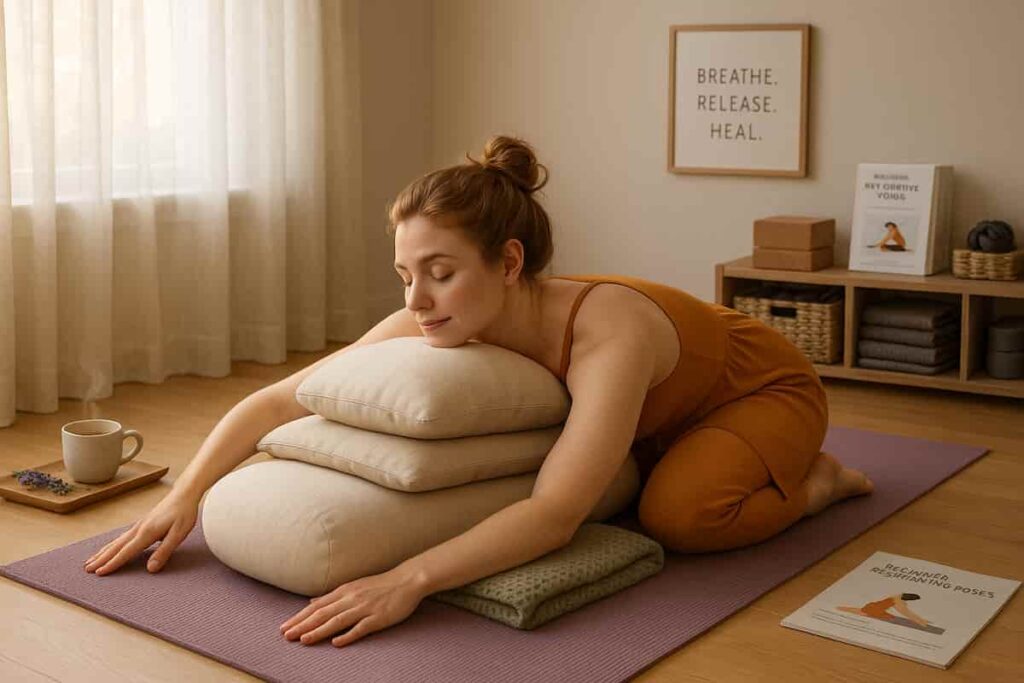
2. The “Lazy Butterfly” (Reclined Bound Angle)
- Lie down and put the soles of your feet together like you’re clapping with your legs.
- Let your knees fall open – no need to force it, they’ll go where they want.
- Warning: May cause accidental napping.
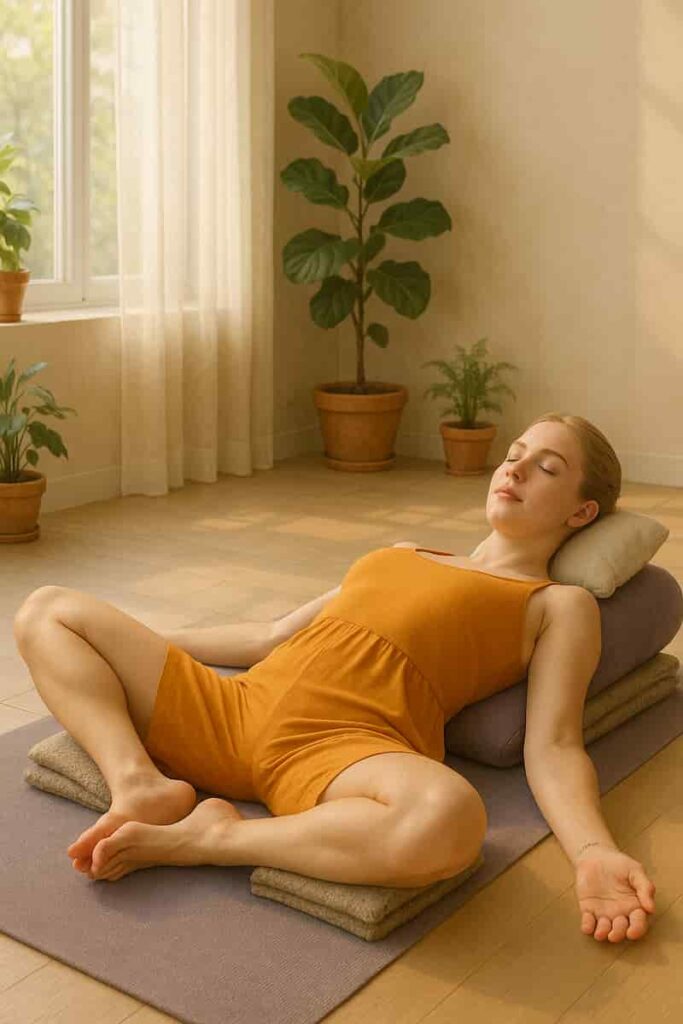
3. The “Upside Down Zombie” (Legs Up the Wall)
- Scoot your butt against a wall and throw your legs up.
- If your hamstrings scream, bend your knees slightly.
- Bonus: Perfect for pretending you’re a bug that got stuck on its back.

4. The “Halfway Bridge” (Supported Bridge)
- Lie down, bend your knees, and lift your hips just enough to slide a pillow underneath.
- Now you’re not quite sitting, not quite lying – just comfortably confused.
- Feels like: That moment when you wake up but don’t have to get up yet.
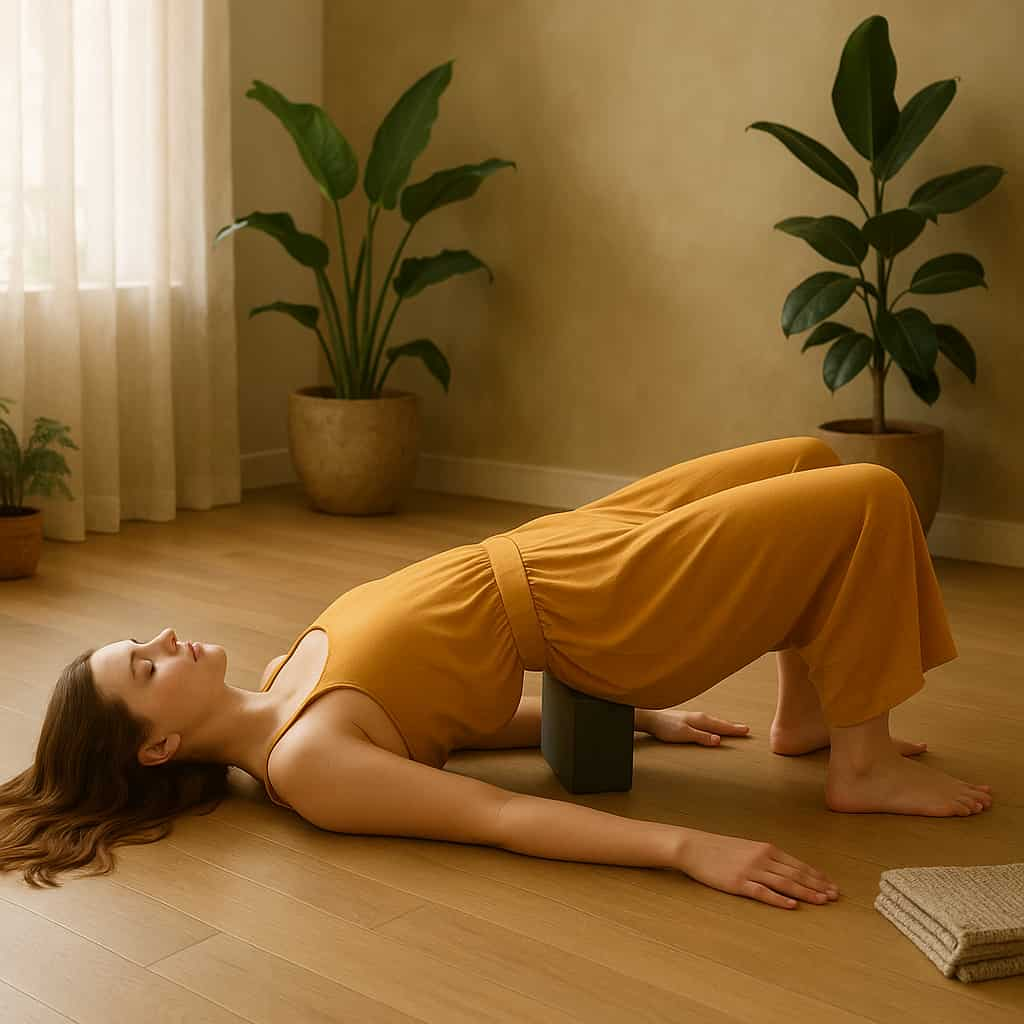
5. The “Corpse Pose Plus” (Savasana with Extras)
- Lie flat like a starfish, but fancy:
- Pillow under your head (because you’re worth it)
- Blanket over your body (instant hug)
- Socks on if your feet are cold (duh)
- Advanced move: Try not to immediately fall asleep (good luck with that).
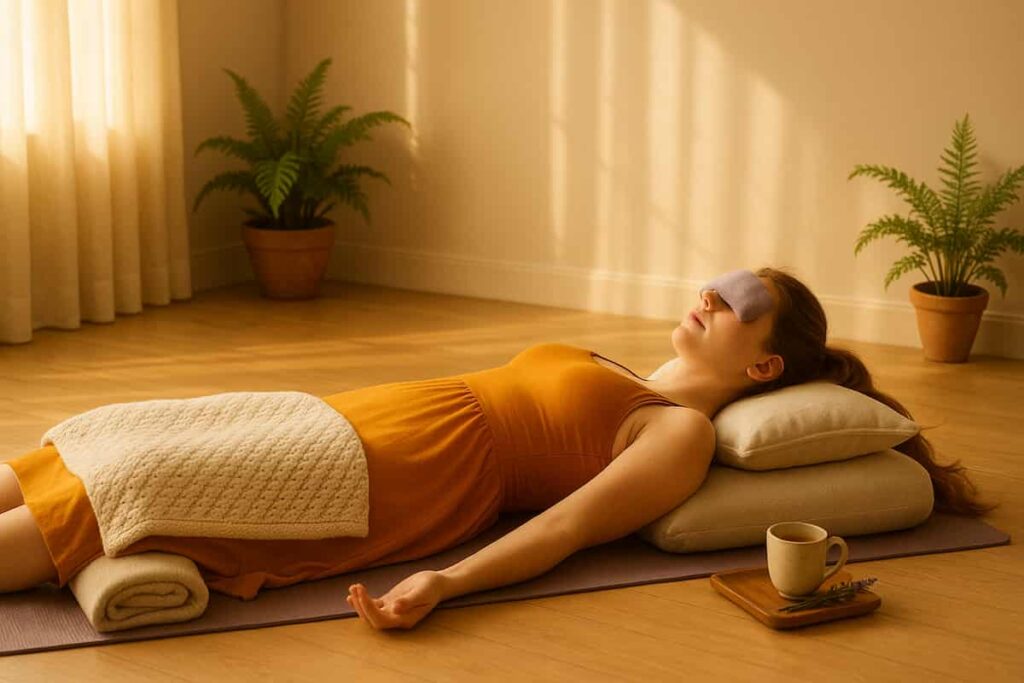
Why This Works
Your body is like a stressed-out iPhone – sometimes it just needs to turn off and on again. These poses are the equivalent of holding down the power button (but way more comfortable).
Sample Restorative Yoga Sequence (20 Minutes)
Let’s be real—some days, you need yoga that’s easier than deciding what to eat for dinner. This sequence? It’s basically napping with benefits. No fancy moves, no sweating—just you, some cozy props, and permission to do less.
1. Supported Child’s Pose (5 mins)
AKA: “The I Give Up” Position
- Kneel, sit back on your heels, and flop your chest onto a pillow stack.
- Turn your head to one side like you’re eavesdropping on the floor.
- Breathe here and pretend your to-do list doesn’t exist.
2. Reclined Bound Angle (5 mins)
AKA: “Lazy Butterfly Mode”
- Lie back on a bolster or folded blanket, put your feet together, and let your knees flop open.
- Pro tip: Add pillows under your thighs if your hips groan.
- Feels like: Your legs are clapping for your life choices.
3. Legs Up the Wall (4 mins)
AKA: “Upside-Down Zombie”
- Scoot your butt against a wall and throw your legs up. Boom—instant gravity break.
- If your hamstrings scream, bend your knees slightly.
- Bonus: Pretend you’re a bug that’s really committed to relaxing.
4. Supported Bridge (3 mins)
AKA: “Halfway to a Nap”
- Lie down, bend your knees, and lift your hips just enough to slide a pillow or block underneath.
- Let your arms flop out like “I surrender… to comfort.”
- Why it’s magic: Your lower back sighs in relief.
5. Savasana with Props (3 mins)
AKA: “Blanket Burrito of Bliss”
- Lie flat like a starfish, but upgrade it:
- Pillow under your head (because you’re fancy now)
- Blanket over your body (instant hug)
- Socks on (cold feet are mood killers)
- Try not to snore. (No promises.)
Restorative vs Yin Yoga: A Real Person’s Breakdown
Okay look, I used to get these confused too until I actually tried them back-to-back. Here’s the no-bs difference from someone who’s fallen asleep in both:
Restorative Yoga is like…
That feeling when you finally collapse on the couch after a simple-long day. Every pose is basically:
- “Here’s 5 pillows to hug”
- “Let’s cover you in blankets like a toddler”
- “No really, don’t even TRY to hold yourself up”
I did a class once where the teacher tucked us in with weighted blankets. I’m pretty I actually drooled.
Yin Yoga is more like…
When your massage therapist finds that knot you’ve been ignoring for months and goes “oh honey…”
You’ll be:
- Sitting in awkward positions just long enough to think “wait does this actually hurt?”
- Feeling those weird pops and cracks (the good kind)
- Surprised you can suddenly touch your toes afterward
Actual conversation from my first yin class:
Me: whispering “Um, is my hip supposed to make that noise?”
Teacher: laughing “Yep, that’s the sound of regret from all those hours sitting at your desk.”
Which one’s better? Depends on your mood:
- Wound up like a spring? Do restorative.
- Stiff as a board? Do yin.
- Can’t decide? Do restorative first THEN yin – it’s like stretching warm cookie dough.
Pro tip: The real test is how you feel after:
- Restorative = just took a Xanax (but natural)
- Yin = like someone oiled your joints
(And no, I don’t get paid to say this – I just really like not being a tense ball of stress anymore.)
How to Set Up Your Restorative Yoga Space at Home
Let’s face it – life’s exhausting enough without having to go to a fancy studio. So here’s how to create your perfect chill zone at home:
First Things First: Raid Your House for These Items
- Obviously you’ll need a yoga mat or soft rug (because floor burns ruin the vibe)
- Then gather every pillow in your place – couch cushions count too!
- While you’re at it, grab some thick books (finally putting that unread self-help book to work)
- Most importantly, steal back that cozy blanket from your pet/kid/partner
Next: Transform Your Space Into a Relaxation Oasis
- First off, turn off those harsh overhead lights – they’re basically anxiety in bulb form
- Instead, try these lighting hacks:
- Drape a scarf over your lamp (instant mood lighting)
- Light some candles (if you can stay awake near them)
- After that, set the soundscape:
- Nature sounds (ocean waves are like a vacation for your ears)
- Soft piano music (no words = no brain distractions)
Here’s How to Take It to the Next Level
- Before you start, set a gentle timer (so you’re not clock-watching)
- Then make sure you’re warm enough (shivering is not relaxing)
- Finally, hide your phone (yes, even from yourself)
Why This Actually Works
At first glance, it might seem too simple. But here’s the thing – your brain craves routine. When you consistently use this space for relaxation, eventually just sitting there will trigger calmness. Unlike your bed (where you’ll just worry), this becomes your designated chill zone.
Absolutely! It’s basically “napping with purpose” – no fancy moves required. If you can lie down and breathe, you’re already winning. Plus, every pose can be adjusted to your “I haven’t moved since 1997” fitness level.
Please do! Even 10 minutes of supported laziness helps reset your stress meter. Think of it like brushing your teeth, but for your nervous system. Warning: May cause excessive relaxation.
Nope! While bolsters are nice, your couch cushions work just fine. Get creative with:
Pillows (the more mismatched, the better)
Towels (rolled up for makeshift bolsters)
Books (finally using that unread self-help book)
Tips for Beginners
Okay, look – I remember my first restorative yoga class. I showed up in workout clothes and immediately felt overdressed. Here’s what I wish someone had told me:
1. Start shorter than you think
When I first tried this at home, I set a timer for 5 minutes. Know what happened? I fell asleep in 3. That’s normal. Your body might be more tired than you realize.
2. Your brain will rebel
In my early sessions, I’d suddenly remember:
- Unpaid bills
- That embarrassing middle school memory
- Whether I left the oven on
This isn’t failure – it’s your brain finally having space to dump its junk drawer.
3. Get help at first
I stubbornly tried learning from pictures for weeks before caving and taking a class. The teacher adjusted my pillow placement and – game changer. Sometimes you need eyes on you.
4. Comfort isn’t optional
Early mistake: I tried to “tough out” a pose. My shoulder ached for days. Now? If it’s not blissful after 1 minute, I grab more props. Your future self will thank you.
Real talk: It might feel weird at first to just… lie there. But stick with it. After my third session, I actually cried from relief. Your body’s been waiting for this.
Final Thoughts: The Power of Doing Nothing
Here’s the truth nobody tells you: real healing begins when you stop trying so damn hard. Restorative yoga isn’t about achievement—it’s about remembering how to be instead of do. When you finally let your body sink into those pillows and just breathe, something shifts. The tightness in your shoulders you forgot was there starts to melt. The mental to-do list quiets down. For those few minutes, you’re not chasing anything—you’re just here, and that’s enough. That’s the magic. That’s where the real work happens. Now put down your phone and go lie down—you’ve got some nothing to do.
Recommended Reads:
🔗 Love mindful living? Follow us on Pinterest and LinkedIn for daily meditation tips, peaceful visuals, and more




